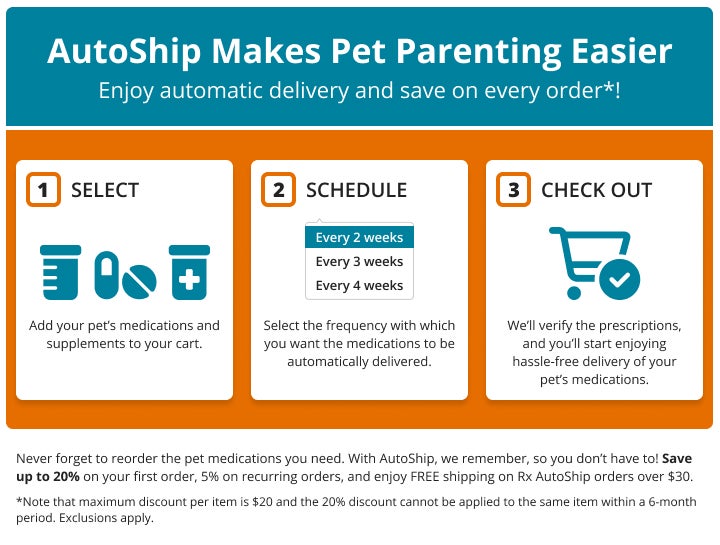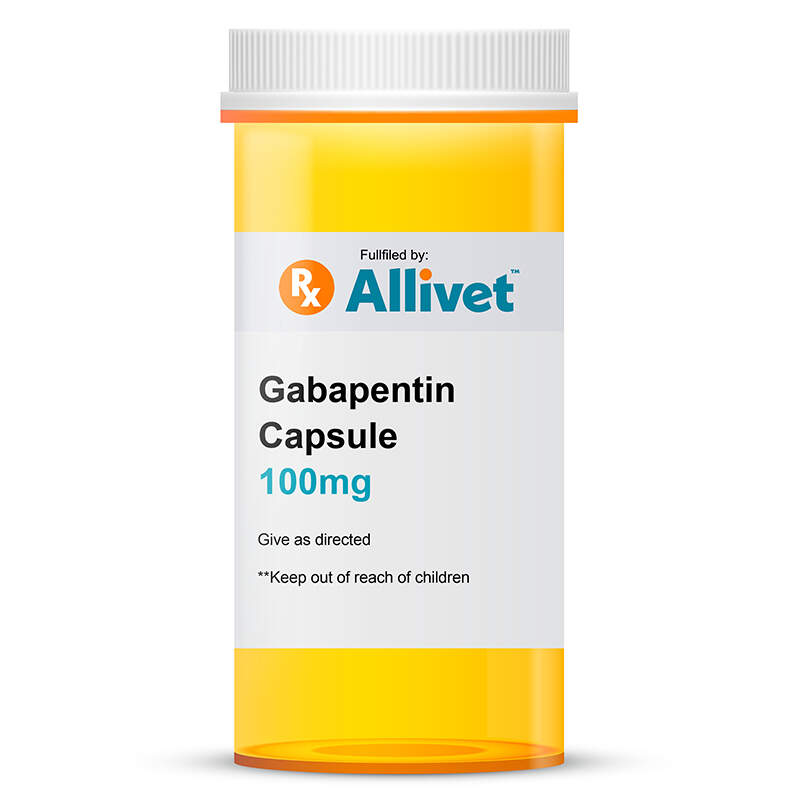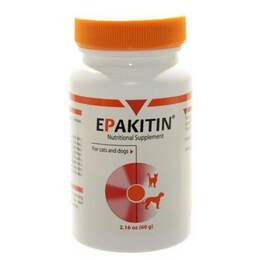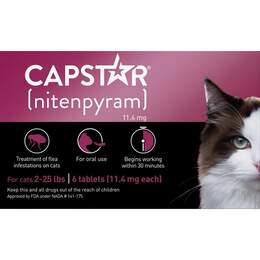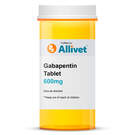

Gabapentin Capsule Rx
- Save on your Autoship
- Hassle-free: Easily Skip or Change Shipment Dates.
- Commitment-free: Cancel anytime
- Free Shipping.
With AutoShip, we remember so you don’t have to! Learn more
- Manages chronic pain
- May treat refractory seizures
- Can be prescribed to regulate seizures in foals who suffer from hypoxic-ischemic encephalopathy (HIE)
If your dog or cat has been prescribed gabapentin for seizure or pain or as part of a combination of medicines, you may be on the hunt for more information about it, as any pet parent would. Most people haven’t heard of gabapentin, which was initially developed for humans, and want to know more about it when prescribed for their pets. If gabapentin has been prescribed for your pet, you must know its use and any possible side effects.
What Is Gabapentin?
Gabapentin (the human version is known as Neurontin®), is often prescribed by veterinarians to relieve chronic pain and treat complex seizure disorders in dogs and cats. It is generally one of a combination of drugs when used to treat seizures. It is also used to treat cats for fear and anxiety caused by veterinary visits.
The use of gabapentin in dogs and cats for pain and seizures in an extra-label or off-label usage. This is not uncommon in veterinary medicine as many drugs are commonly prescribed for off-label use. Follow your veterinarian’s instructions very carefully as they may be very different than what is on the label. You can only get gabapentin from a veterinarian or with a prescription from a veterinarian.
How Does Gabapentin Work?
Even though gabapentin is often prescribed by veterinarians, how it works or its mechanism of action is not well-known. However, it has been established that it has two main effects when administered to pets: anti-seizure and pain relief.
However, there are some theories. It is thought that this drug mimics the activity of GABA, a neurotransmitter that helps calm down nerve activity. This prevents electrical activity in the brain and minimizes the risk of your pet having seizures.
When administered for pain, gabapentin doesn’t impact pain directly but instead acts to dampen the nervous system. It reduces calcium transportation by inhibiting calcium channels in the brain. Because these channels govern the pain response, blocking them decreases pain sensation. Gabapentin quiets the nervous system rather than blocking pain signals. When pain signals get to the brain, they are not strong enough to trigger a pain response.
How Is Gabapentin Administered?
Gabapentin capsules, tablets, or liquids are administered by mouth, with or without food. However, if your pet throws up after getting their dose on an empty stomach, give future doses with a treat or food. The best time to give this drug is just before feeding. If using a liquid formulation, measure the dose carefully.
Under no circumstances should you give your pet the oral liquid formulation made for humans. The human version often contains xylitol, which is toxic for dogs. In addition, do not stop giving your pet this medication suddenly in pets that have epilepsy since this can cause withdrawal seizures. Once given, the medicine works quickly, in approximately 1-2 hours, and improvement or relief from symptoms should follow.
What Is Gabapentin Used for in Cats and Dogs?
A mentioned above, gabapentin is often prescribed to help with seizures, pain, and anxiety in cats and dogs. Here’s a closer look at how a drug works when treating these conditions.
Seizure Prevention
The anticonvulsant properties of gabapentin are beneficial as adjunctive or more than one medicine for cats and dogs with refractory seizures. It is also used if a pet’s current medication plan is no longer working well.
Pain Management
In addition to being used for treating seizures, gabapentin is also prescribed for relief from chronic pain and neuropathic pain. Because of its analgesic properties, the drug is often used for chronic pain caused by degenerative joint disease.
It has also been shown to be beneficial when used in combination with other pain medicines such as nonsteroidal anti-inflammatory drugs (NSAIDs) or opioids to help control pain from surgery.
Anxiety Relief
Although gabapentin is well known for treating pain and seizures, it is also becoming increasingly popular for adjunctive therapy for anxiety in cats and dogs.
Risk Factors and Side Effects
While safe and effective when used as prescribed by your veterinarian, gabapentin does have side effects in some pets. The primary side effect of gabapentin is sedation, which may not be an adverse effect. This is generally dose-related and goes away if the dose is decreased.
If your pet is overly sedated when given gabapentin, first reduce the dose. You can then slowly increase it to the therapeutic level prescribed by your veterinarian over a time frame of a few weeks. Sedation is more common in pets who are taking other sedating drugs such as tramadol.
Dizziness is another mild side effect of gabapentin. Your pet be a little unsteady after the first dose or two. Senior pets may have a more pronounced loss of coordination and more severe dizziness.
Uncommon but more severe side effects include:
- Vomiting
- Diarrhea
- Depression
- Loss of coordination
- Bulging eyes
- Lethargy or sedation
Contact your veterinarian if you notice any of the above symptoms.
Weakness and dose-dependent ataxia or loss of full control of the body’s movements, especially in older pet patients that have decreased muscle strength. The liver and kidneys metabolize gabapentin in dogs, and how cats clear it is unknown but presumed to be mainly by the kidneys. For these reasons, the drug may accumulate rapidly in the system of cats and dogs with liver issues and dogs with kidney disease, and adverse effects may occur more rapidly. In these patients, your veterinarian will start with a lower dose and slowly increase it.
Gabapentin should not be given to pets with a known allergy or hypersensitivity to it and not to pregnant or nursing cats and dogs. Possible drug interactions include antacids, morphine, and hydrocodone. Consult with your veterinarian to determine if any medication or supplements could interact with gabapentin.
Gabapentin is generally well-tolerated by cats and dogs, and deadly toxicity is unlikely unless your pet’s liver or kidneys are already compromised. Tremors, stumbling, and profound sedation have been observed in cases of profound sedation. If you see these symptoms in your pet, contact your veterinarian immediately.
Gabapentin Use with Other Drugs
Rimadyl is a commonly used NSAID for dogs and is only used for cats under strict veterinary supervision. NSAIDs such as aspirin, Aleve, and ibuprofen are often used for pain relief in humans as well as cats and dogs. Using gabapentin with Rimadyl or another NSAID safe for dogs effectively controls mild to moderate pain. Never give your pets human NSAIDs.
Tramadol is an opioid used frequently to relieve moderate to severe pain in humans and dogs, but tramadol alone isn’t always effective. Many vets find that tramadol and gabapentin work best when taken together to provide the most optimal relief for chronic or acute pain. Some vets also prescribe a combination of gabapentin, tramadol, and an NSAID to relieve severe pain.
Trazodone is often prescribed for anxiety in pets and is safe to use in gabapentin. Numerous pharmacies carry combination solutions with both gabapentin and Trazadone, which are often prescribed for anxiety.
DO NOT crush or open the pill or tablet. Medication is formulated in specific ways. By breaking or opening the capsule, you could be changing the way the drug interacts with the body.
How to Give Your Pets Gabapentin
It is essential to follow your veterinarian’s instructions when giving your dog gabapentin so that your cat or dog doesn’t become over-sedated. If you miss a dose for your cat or dog, you can give it to them as soon as you remember, as long as it is not too close to their next scheduled dose. If the next scheduled dose is soon, just skip it and continue with the regular schedule.
Gabapentin for pets usually comes in the form of a pill or a tablet. Some dogs will easily take a pill from your hand and not give it another thought. Others may need a little incentive. Wrapping the pill in peanut butter or bacon usually works. Using a pill pocket is another way to get your dog to take gabapentin.
Cats are another matter altogether. Some cats may willingly take a pill, but many do not. They may take a pill or tablet if you hide it in their food. You can also try to put it in their mouth and get them to take it. Tilt your cat’s head back gently. Place the pill at the back of your cats’ throat. Close their mouth and massage the outside of their throat to encourage swallowing.


